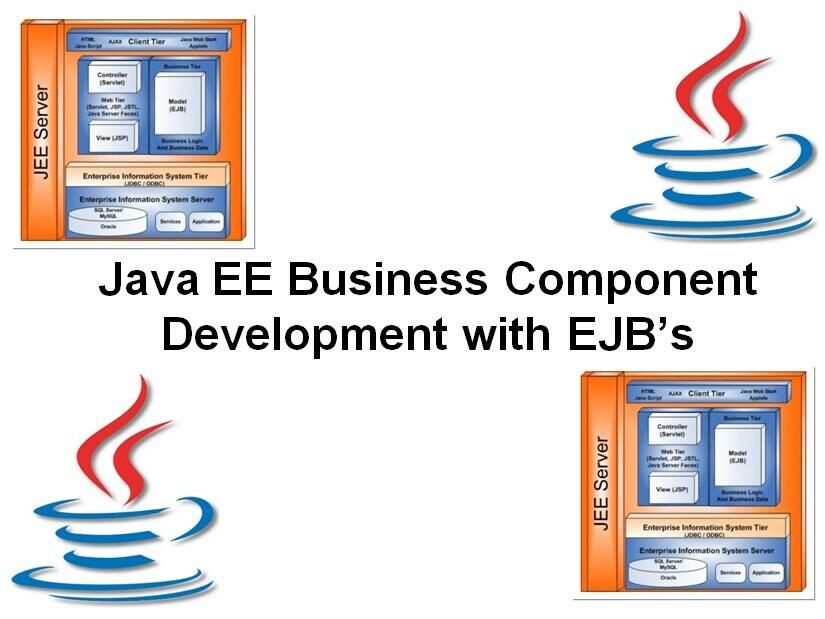- Leren door doen
- Trainers met praktijkervaring
- Klassikale trainingen
- Gedetailleerd cursusmateriaal
- Duidelijke inhoudsbeschrijving
- Maatwerk inhoud mogelijk
- Trainingen die doorgaan
- Kleine groepen
De cursus Java EE EJB Business Components richt zich op Enterprise JavaBeans, zoals gespecificeerd in de EJB 3.x specificatie als onderdeel van de laatste versie van Java EE.
Aandacht wordt besteed aan de 3 verschillende types van Enterprise Beans zoals Session Beans, Message Driven Beans en Singleton beans.
Het Java Naming and Directory Interface (JNDI) wordt besproken evenals hoe beans kunnen worden gevonden en geïnstantieerd door injection. Hierbij komen de lifecycles van de beans aan de orde en worden concurrency problemen besproken.
Een belangrijke rol is weggelegd voor annotaties. Deze komen op veel plaatsen in de cursus aan de orde zoals bij het leggen van links met resources en de realisatie van persistence.
Aandacht wordt besteed aan het gebruik van EJB Query Language en de implementatie van Object Relational Mapping in EJB 3.x.
Ook komen de transacties in een Java EE omgeving aan bod en wordt aandacht besteed aan de Java EE security architectuur en de verschillende authenticatie en autorisatie strategieën. JMS en de toepassing ervan in combinatie met Message Driven Beans staan eveneens op het programma.
En tot slot wordt de aandacht gericht op best practices en design patterns in EJB technologie.
Java developers die met Java EE EJB business componenten willen leren ontwikkelen.
Kennis van en ervaring met programmeren in Java en de beginselen van object oriëntatie is vereist om aan deze cursus te kunnen deelnemen. Kennis van Java EE Web Development is wenselijk.
De theorie wordt gepresenteerd in de vorm van slides en afgewisseld met praktische oefeningen. Demos dienen ter verheldering van de theorie. Alle onderwerpen die worden gevraagd op het Java EE Enterprise JavaBeans Developer Certified Expert Exam (1Z0-895) worden besproken. De cursustijden zijn van 9.30 tot 16.30.
De deelnemers krijgen na het goed doorlopen van de cursus een officieel certificaat Java EE EJB Business Components.

Module 1 : Java EE Intro |
Module 2 : Enterprise Java Beans (EJB) |
Module 3 : JNDI and Injection |
| Java Editions Java EE versions Enterprise Applications Java EE Servers Web Components EJB Components JavaBean components Web Services Java EE API's EAR Files Deployment Descriptors Annotations |
Session Beans Statefull and Stateless Life Cycle Session Bean Architecture of an EJB EJB Object at work Client Access Remote versus Local Clients Web Service Clients Singleton Beans Concurrency management strategy Message Driven beans Life Cycle Message Driven Beans |
Naming Services Directory Services Locate resources with JNDI JNDI Architecture JNDI InitialContext JNDI Naming Context EJB Environment Standard JNDI SubContexts Dependency Injection DataSource Injection Injection of EJB References Example EJB Injection |
Module 4 : Java Persistence API |
Module 5 : Callbacks and Listeners |
Module 6 : Session Beans |
| Entity Classes Entity Manager Persistence Context Entity Identity Entity Lifecycle Entity Relationships Persisting Objects Removing Objects Merging Objects Managing Identity |
Life Cycle Callback methods Entity Listeners Life Cycle Callback Rules Signature Life Cycle Callbacks Signature Entity Listeners @PrePersist and @PostPersist @PreRemove and @PostRemove @PreUpdate and @PostLoad Multiple Invocation Callbacks Invocation Order |
Session Beans Overview Stateless Session Beans Event callbacks Asynchronous communication Singleton session bean Singleton concurrency access Stateful Session Beans Passivating and Activating Remote Business Interface Calling Business Methods |
Module 7 : Message Driven Beans |
Module 8 : Timer Service |
Module 9 : Interceptors |
| Messaging Characteristics Publish and Subscribe Point tot Point What is JMS? Message types Message Driven Beans MessageListeners onMessage method |
Timer Service Scheduling Timers Creating Timers Timeout method rules Canceling and Saving Timers Timer Service interface Timer interface Timer handle interface |
What are Interceptors? Interceptor Classes @AroundInvoke Example Interceptor Interceptor Lifecycle Interceptor Types Default Interceptors Exclude Interceptors |
Module 10 : Transactions |
Module 11 : Security |
Module 12 : EJB and Web Services |
| Transactions Demarcating Boundaries Container Managed Bean Managed Client Managed Transaction Attributes Session Synchronization Before Completion After Completion |
Java EE and EJB Security Programmatic Security Java EE authorization strategies Declarative Security Using Programmatic Security Method Permissions DeclareRoles ejb-role-ref role-link |
Web Service Types REST versus SOAP Structure SOAP Message What is WSDL? Stateless Session Bean Endpoint JAX-WS Publishing an Endpoint Web Service Annotations JAX-RS |
Module 13 : EJB Best Practices |
Module 14 : Clustering |
Optional : Annotations and JMX |
| Define Best Practices Benefits of EJB best practices Java EE Patterns Effective Exception Handling EJB Design Patterns Session Facade Composite View Front Controller Business Delegate Service to Worker |
What is clustering? Thin Client Clustering Thick Client Clustering Clustering Stack JGroups and JCache HA-JNDI HA-Smart Proxies SLSBs and SFSBs HTTP Session Replication POJO Clustering |
What are annotations? Single value annotations Normal annotations Meta-Annotations What is JMX? Managed Beans Naming MBeans MBean Server Registering Mbeans Notifications |
